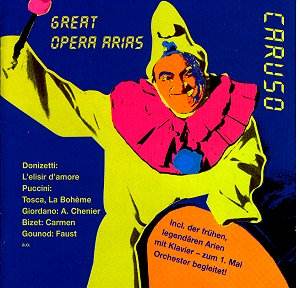All
Caruso fans, or indeed all lovers of great singing, will be familiar
with the much-released items on this disc. What will make them
do a double take (as I did) will be the heading ‘Caruso – The
Digital Recordings’. It is in fact part of a series from BMG that
aims to try and give us the famous tenor in ‘modern sound’. Many
companies have tried their own various tactics to present the
great singer in more acceptable sound, probably the most successful
being Nimbus, whose ‘Prima Voce’ series cleaned up the crackle
of many old recordings without too much technological intervention.
Where
this differs is that BMG have actually separated the voice from
the original accompaniments, and having filtered out the old orchestra
or piano, have re-recorded an exact duplicate with a modern orchestra.
The result is very odd at first, and the overall success is patchy,
but at its best it is quite an amazing listening experience.
It
has to be said straight away that the oldest recordings, dating
from way back in 1902 (thus being some of the very earliest examples
of primitive recorded sound) work least well. The opening item
Amor ti vieta, famous for having the composer at the piano,
has obviously given the engineers some problems. Filtering out
the original piano must have been more difficult than the orchestra,
and the wonderfully full, modern-sounding introduction is completely
at odds with the distant, ‘doctored’ sound of the voice. Those
collectors familiar with the original will recognise the same
lustrous quality to the voice (he was in his prime here, which
makes it more of a pity) but the two simply don’t go together.
This is basically true of all the items from those earliest masters,
which go from 1902 through to 1907, over half the disc,
Things
improve dramatically when we get to recordings made from 1910
(Pagliacci and Otello) and there are two which take your breath
away from 1913 (Rigoletto and Manon Lescaut). Recording techniques
had obviously come on in leaps and bounds in the following decade,
and these arias (all from Camden or New York sessions) show the
voice still in its prime, but with tremendous presence and clarity.
In fact, here the orchestra and singer go together so well that
you could fool some people into thinking this was newly discovered
material! Credit here must go to Gottfried Rabl and his excellent
Vienna forces, who have to follow every quirk of phrasing, every
shift in tempo and all the famous flexible rubato that were part
of the singer’s tradition. The gear changes in Canio’s aria from
Pagliacci put them on their mettle, and the result has wonderful
panache and a real sense of unbuttoned verismo. The dark baritonal
tones of Caruso’s Otello make one long to hear a complete rendition,
and here the modern sounding orchestral backing really is a plus.
He performs the Duke’s arias from Rigoletto with a superb sense
of stylish swagger, the head voice rising thrillingly to the high
b flat towards the end of Ella mi fu rapita. Best of all
is Des Grieux’s gloriously youthful love song to Manon Lescaut
Donna non vidi mai. Here we have a performing tradition
again directly relating to the composer, with an almost improvisatory
abandon and free-floating stream of Italianate lyricism that is
not easily forgotten.
It’s
difficult to really mention recording quality in this context,
but the orchestral contribution is certainly first-rate, and whether
you warm to this admittedly rather gimmicky idea will be personal.
No texts are included, but the booklet note fills the listener
in on Caruso’s legacy and this particular recording venture. As
I find myself playing those few tracks time and again, I would
have to conclude that this really is worth investigating, even
for curiosity value. And that voice…..
Tony
Haywood

